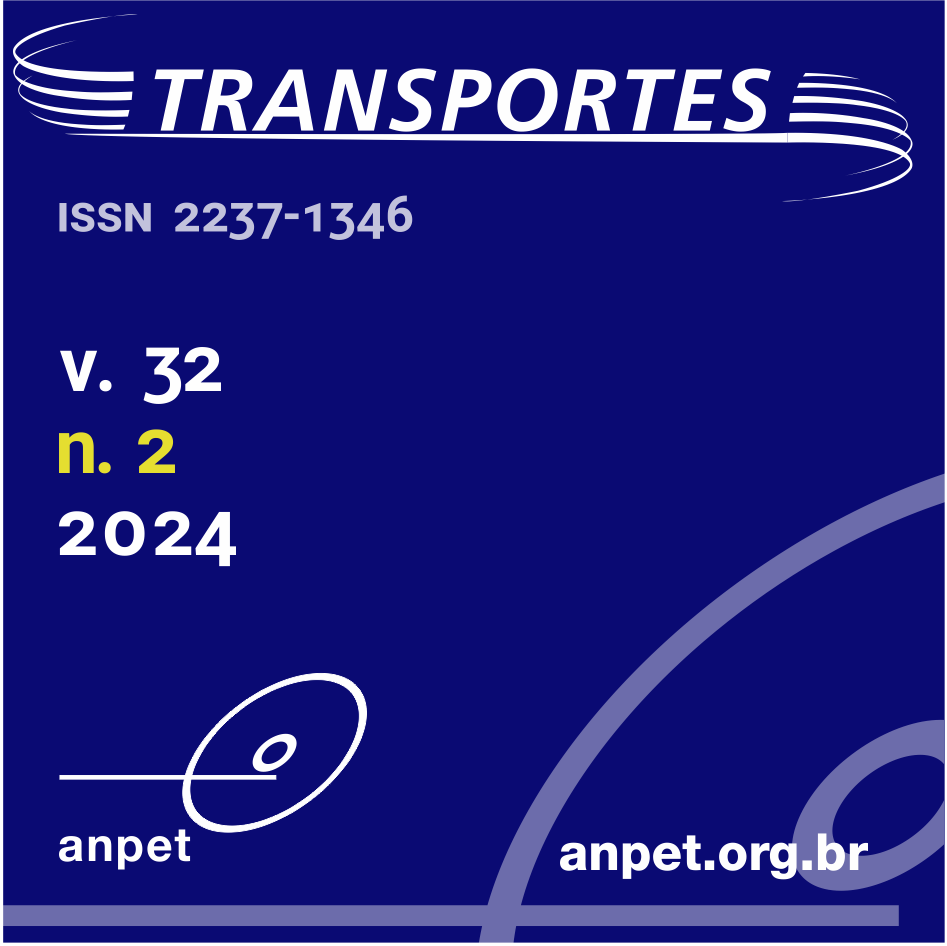Dosagem do agente rejuvenescedor Sylvaroad com base nas propriedades reológicas de ligante asfáltico envelhecid
DOI:
https://doi.org/10.58922/transportes.v32i2.2920Palavras-chave:
Performance grade, Agente rejuvenescedor, Ligante asfáltico, Reclaimed asphalt pavementResumo
A técnica de utilização de agentes rejuvenescedores (AR) na recuperação das propriedades de ligantes envelhecidos ainda tem muito a ser desenvolvida, considerando que a quantidade de AR afeta diretamente o desempenho dos ligantes à fadiga e deformação permanente, principais fatores de degradação do pavimento. Esta pesquisa avaliou os métodos de dosagem de AR Sylvaroad RP1000 em ligante envelhecido, com base em parâmetros reológicos. O ligante foi extraído de mistura asfáltica fresada (RAP), por meio de centrifugação e rotoevaporação. Foram produzidas amostras com 0, 3, 5, 7 e 10% de AR e submetidas a ensaios na Estufa de Película Delgada Rotacional (RTFOT) e Reômetro de Cisalhamento Dinâmico (DSR). A dosagem ideal foi avaliada com base no Performance Grade de alta temperatura (PGH) do ligante virgem. Os parâmetros de suscetibilidade à deformação permanente e à fadiga também foram obtidos pelos ensaios de Fluência e Recuperação sob Tensão Múltipla (MSCR) e Varredura de Amplitude Linear (LAS). Os resultados mostraram a eficácia do AR, cujo teor capaz de recuperar o PGH do ligante virgem foi de 10,6% da massa do ligante envelhecido. Este teor apresentou resultados satisfatórios de compliância não recuperável, taxa de recuperação e resistência à fadiga, inclusive superiores aos do ligante virgem.
Downloads
Referências
ASTM (2006) ASTM D 4402: Standard Test Method for Viscosity Determination of Asphalt at Elevated Temperatures Using a Rotational Viscometer. Philadelphia, USA: ASTM.
ASTM (2015) ASTM D 7175: Standard Test Method for Determining the Rheological Properties of Asphalt Binder Using a Dynamic Shear Rheometer. Philadelphia, USA: ASTM.
ASTM (2016a) ASTM D 36: Standard Test Method for Softening Point of Bitumen (Ring-and-Ball Apparatus). Philadelphia, USA, ASTM.
ASTM (2016b) ASTM D 6373: Standard Specification for Performance Graded Asphalt Binder. Philadelphia, USA: ASTM.
ASTM (2016c) ASTM D 7643: Standard Practice for Determining the Continuous Grading Temperatures and Continuous Grades for PG Graded Asphalt Binders. Philadelphia, USA: ASTM.
ASTM (2017) ASTM D 113: Standard Test Method for Ductility of Asphalt Materials. Philadelphia, USA: ASTM.
ASTM (2018a) ASTM D 92: Standard Test Method for Flash and Fire Points by Cleveland Open Cup Tester. Philadelphia, USA: ASTM.
ASTM (2018b) ASTM D 70: Standard Test Method for Density of Semi-Solid Asphalt Binder (Pycnometer Method). Philadelphia, USA: ASTM.
ASTM (2019) ASTM D 2872: Standard Test Method for Effect of Heat and Air on a Moving Film of Asphalt (Rolling Thin-Film Oven Test). Philadelphia, USA: ASTM.
ASTM (2020a) ASTM D 7405: Multiple Stress Creep and Recovery (MSCR) of Asphalt Binder Using a Dynamic Shear Rheometer. Philadelphia, USA: ASTM.
ASTM (2020b) ASTM D5: Standard Test Method for Penetration of Bituminous Materials. Philadelphia, USA: ASTM.
AASHTO (2018) AASHTO M 332: Standard Specification for Performance-Graded Asphalt Binder Using Multiple Stress Creep Recovery (MSCR) Test. Philadelphia, USA: ASTM.
AASHTO (2020) AASHTO T 391: Standard Method of Test for Estimating Fatigue Resistance of Asphalt Binders Using the Linear Amplitude Sweep. Washington, D.C, USA: AASHTO.
Arámbula-Mercado, E.; F. Kaseer; A.E. Martin et al. (2018) Evaluation of recycling agent dosage selection and incorporation methods for asphalt mixtures with high RAP and RAS contents, Construction & Building Materials, v. 158, p. 432-42. DOI: 10.1016/j. conbuildmat.2017.10.024. DOI: https://doi.org/10.1016/j.conbuildmat.2017.10.024
Asadi, B.; N. Tabatabaee and R. Hajj (2021) Use of linear amplitude sweep test as a damage tolerance or fracture test to determine the optimum content of asphalt rejuvenator, Construction & Building Materials, v. 300, p. 123983. DOI: 10.1016/j. conbuildmat.2021.123983. DOI: https://doi.org/10.1016/j.conbuildmat.2021.123983
Bajaj, A.; A.E. Martin; G. King et al. (2020) Evaluation and classification of recycling agents for asphalt binders, Construction & Building Materials, v. 260, p. 119864. DOI: 10.1016/j.conbuildmat.2020.119864. DOI: https://doi.org/10.1016/j.conbuildmat.2020.119864
Cao, X.; H. Wang; X. Cao et al. (2018) Investigation of rheological and chemical properties of asphalt binder rejuvenated with waste vegetable oil, Construction & Building Materials, v. 180, p. 455-63. DOI: 10.1016/j.conbuildmat.2018.06.001. DOI: https://doi.org/10.1016/j.conbuildmat.2018.06.001
Chen, H.; Y. Zhang and H.U. Bahia (2021) Estimating asphalt binder fatigue at multiple temperatures using a simplified pseudo-strain energy analysis approach in the LAS test, Construction & Building Materials, v. 266, p. 120911. DOI: 10.1016/j. conbuildmat.2020.120911. DOI: https://doi.org/10.1016/j.conbuildmat.2020.120911
Deng, M.; X. Cao; Z. Li et al. (2022) Investigating properties and intermolecular interactions of sludge bio-oil modified asphalt, Journal of Molecular Liquids, v. 360, p. 119415. DOI: 10.1016/j.molliq.2022.119415. DOI: https://doi.org/10.1016/j.molliq.2022.119415
Espinoza-Luque, A.F.; I.L. Al-Qadi and H. Ozer (2018) Optimizing rejuvenator content in asphalt concrete to enhance its durability, Construction & Building Materials, v. 179, p. 642-8. DOI: 10.1016/j.conbuildmat.2018.05.256. DOI: https://doi.org/10.1016/j.conbuildmat.2018.05.256
Fang, Y.; Z. Zhang; J. Yang et al. (2021) Comprehensive review on the application of bio-rejuvenator in the regeneration of waste asphalt materials, Construction & Building Materials, v. 295, p. 123631. DOI: 10.1016/j.conbuildmat.2021.123631. DOI: https://doi.org/10.1016/j.conbuildmat.2021.123631
Gadler, F. (2018) Desempenho e Propriedades Mecânicas de Misturas Asfálticas Mornas Produzidas com Revestimento Asfáltico Fresado e Agregado de Resíduo de Concreto em Substituição da Fração Graúda e Miúda da Granulometria. Theses (Master’s Degree in Civil Engineering). Universidade Federal do Paraná, Curitiba. Available at: <https://hdl.handle.net/1884/69718> (accessed 05/15/2023).
Hospodka, M.; B. Hofko and R. Blab (2018) Impact of distillation temperature on the solvent residue and viscoelastic properties of asphalt binders, Road Materials and Pavement Design, v. 19, n. 6, p. 1275-87. DOI: 10.1080/14680629.2017.1304234. DOI: https://doi.org/10.1080/14680629.2017.1304234
Huang, Y.H. (2004) Pavement Analysis and Design (2nd ed.). Upper Saddle River, USA: Pearson Prentice Hall.
Im, S.; P. Karki and F. Zhou (2016) Development of new mix design method for asphalt mixtures containing RAP and rejuvenators, Construction & Building Materials, v. 115, p. 727-34. DOI: 10.1016/j.conbuildmat.2016.04.081. DOI: https://doi.org/10.1016/j.conbuildmat.2016.04.081
Kaseer, F.; E. Arambula-Mercado; L.G. Cucalon et al. (2018a) Performance of asphalt mixtures with high recycled materials content and recycling agent, The International Journal of Pavement Engineering, v. 21, n. 7, p. 863-77. DOI: 10.1080/10298436.2018.1511990. DOI: https://doi.org/10.1080/10298436.2018.1511990
Kaseer, F.; L.G. Cucalon; E. Arámbula-Mercado et al. (2018b) Practical tools for optimizing recycled materials content and recycling agent dosage for improved short- and long-term performance of rejuvenated binder blends and mixtures, Asphalt Paving Technology, v. 87, n. aapt, p. 513-50. DOI: 10.12783/aapt2018/33816. DOI: https://doi.org/10.12783/aapt2018/33816
Kraton Corporation (2017) Safety Data Sheet and Product Data Sheet, Sylvaroad™ RP 1000 Performance Additive. Available at: <https://www.kratonpolymers.cn/literature/SYLVAROAD-RP1000-Performance-Additive-brochure.pdf> (accessed 05/15/2023).
Mikhailenko, P.; P. Ateian and H. Baaj (2020) Extraction and recovery of asphalt binder: a literature review, International Journal of Pavement Research and Technology, v. 13, n. 1, p. 20-31. DOI: 10.1007/s42947-019-0081-5. DOI: https://doi.org/10.1007/s42947-019-0081-5
Mikhailenko, P.; G. Webber and H. Baaj (2021) Evaluation of solvents for asphalt extraction, Road Materials and Pavement Design, v. 22, n. 5, p. 1195-206. DOI: 10.1080/14680629.2019.1661277. DOI: https://doi.org/10.1080/14680629.2019.1661277
Nikolaides, A. (2015) Highway Engineering Pavements: Materials and Control of Quality. Boca Raton, USA: CRC Press.
Noferini, L.; A. Simone; C. Sangiorgi et al. (2017) Investigation on performances of asphalt mixtures made with reclaimed asphalt pavement: effects of interaction between virgin and RAP bitumen, International Journal of Pavement Research and Technology, v. 10, n. 4, p. 322-32. DOI: 10.1016/j.ijprt.2017.03.011. DOI: https://doi.org/10.1016/j.ijprt.2017.03.011
Porot, L. and D. Bell (2019) Bringing recycling to the next level using bio-based rejuvenator. In 18th Australian Asphalt Pavement Association Conference 2019. Sidney, Australia: AFPA, p. 1-13.
Smith, K. (2015) A Rejuvenator Derived from Pine Trees and Natural Asphalt. Available at: <https://www.worldhighways.com/ wh6/feature/rejuvenator-derived-pine-trees-and-natural-asphalt> (accessed 12/05/2023).
Speight, J.G. (2016) Asphalt Materials Science and Technology. Oxford, UK: Elsevier Inc. DOI: https://doi.org/10.1016/B978-0-12-800273-5.00010-6
Wang, J.; S. Lv; J. Liu et al. (2023) Performance evaluation of aged asphalt rejuvenated with various bio-oils based on rheological property index, Journal of Cleaner Production, v. 385, p. 135593. DOI: 10.1016/j.jclepro.2022.135593. DOI: https://doi.org/10.1016/j.jclepro.2022.135593
West, R.C. and A. Copeland (2015). High RAP Asphalt Pavements: Japan Practice - Lessons Learned. Maryland: NAPA. Available at: <https://www.asphaltpavement.org/uploads/documents/EngineeringPubs/IS139_High_RAP_Asphalt_Pavements_Japan_ Practice-lr.pdf> (accessed 12/05/2023).
Yaro, N.S.A.; M.H. Sutanto; N.Z. Habib et al. (2023) Modeling and optimization of rheological properties and aging resistance of asphalt binder incorporating palm oil mill waste using response surface methodology, Journal of Infrastructure Intelligence and Resilience, v. 2, n. 1, p. 100026. DOI: 10.1016/j.iintel.2023.100026. DOI: https://doi.org/10.1016/j.iintel.2023.100026
Zaumanis, M.; R.B. Mallick and R. Frank (2014) Determining optimum rejuvenator dose for asphalt recycling based on Superpave performance grade specifications, Construction & Building Materials, v. 69, p. 159-66. DOI: 10.1016/j.conbuildmat.2014.07.035. DOI: https://doi.org/10.1016/j.conbuildmat.2014.07.035
Zaumanis, M.; R.B. Mallick; L. Poulikakos et al. (2014) Influence of six rejuvenators on the performance properties of Reclaimed Asphalt Pavement (RAP) binder and 100% recycled asphalt mixtures, Construction & Building Materials, v. 71, p. 538-50. DOI: 10.1016/j.conbuildmat.2014.08.073. DOI: https://doi.org/10.1016/j.conbuildmat.2014.08.073
Downloads
Publicado
Como Citar
Edição
Seção
Licença
Copyright (c) 2024 Felipe Tiago Joenck, Vanessa Bacca Couto Joenck, Joe Arnaldo Villena Del Carpio, João Victor Staub de Melo

Este trabalho está licenciado sob uma licença Creative Commons Attribution 4.0 International License.
Ao submeter um manuscrito para publicação neste periódico, todos os seus autores concordam, antecipada e irrestritamente, com os seguintes termos:
- Os autores mantém os direitos autorais e concedem à Transportes o direito de primeira publicação do manuscrito, sem nenhum ônus financeiro, e abrem mão de qualquer outra remuneração pela sua publicação pela ANPET.
- Ao ser publicado pela Transportes, o manuscrito fica automaticamente licenciado sob a Licença Creative Commons CC BY 4.0. Esta licença permite o seu compartilhamento com reconhecimento da autoria e da publicação inicial neste periódico.
- Os autores têm autorização para assumir contratos adicionais separadamente, para distribuição não exclusiva da versão do trabalho publicada neste periódico (por ex.: publicar em repositório institucional ou como capítulo de livro), com reconhecimento da publicação inicial na Transportes, desde que tal contrato não implique num endosso do conteúdo do manuscrito ou do novo veículo pela ANPET.
- Os autores têm permissão e são estimulados a publicar e distribuir seu manuscrito online (por ex.: em repositórios institucionais ou na sua página pessoal) depois de concluído o processo editorial. Como a Transportes é de acesso livre, os autores são estimulados a usar links para o DOI do artigo nesses casos.
- Os autores garantem ter obtido a devida autorização dos seus empregadores para a transferência dos direitos nos termos deste acordo, caso esses empregadores possuam algum direito autoral sobre o manuscrito. Além disso, os autores assumem toda e qualquer responsabilidade sobre possíveis infrações ao direito autoral desses empregadores, isentando a ANPET e a Transportes de toda e qualquer responsabilidade neste sentido.
- Os autores assumem toda responsabilidade sobre o conteúdo do manuscrito, incluindo as devidas e necessárias autorizações para divulgação de dados coletados e resultados obtidos, isentando a ANPET e a Transportes de toda e qualquer responsabilidade neste sentido.









